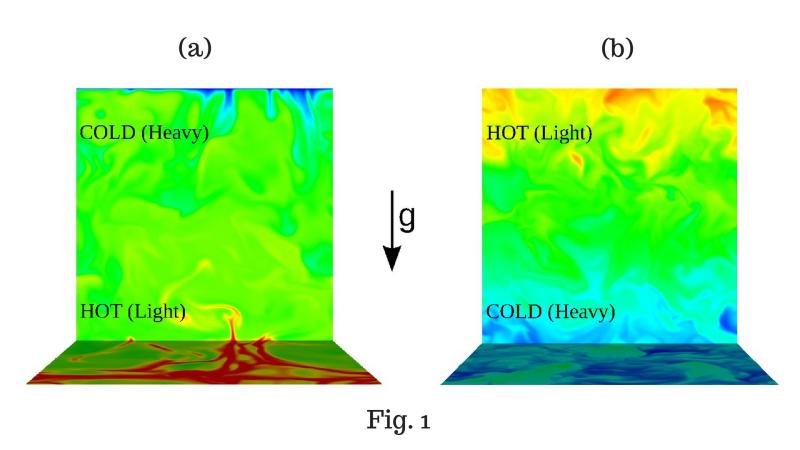
Photos : Verma et. al.
We come across fluids everyday --- from flowing rivers to the winds, and even a steaming cup of hot coffee. A good understanding of the physics behind fluids goes a long way in building efficient water transport, safer aero planes, accurate weather and monsoon predictions, energy-efficient air-conditioning systems, and a whole lot!
So, what causes fluid flows and turbulent motion? Gravity, the attractive force between two massive objects, plays a major role in how fluids behave. It drives heavier fluids downward, and pushes the lighter fluids to the top. This increases the complexity of the flow, and affects the atmospheric and oceanic flows. Heat is the other contributor to fluid flow that leads to thermal convection, in which hotter and lighter fluids rise above due to buoyancy. This phenomenon is observed in our kitchen, in the oceans, and in the stellar and planetary interiors and atmospheres.
In a recent study, using computer simulations and theoretical arguments, scientists from the Indian Institute of Technology, Kanpur, have been able to address a critical problem in buoyancy-driven turbulence that had remained unsolved for more than half a century. Powered by the might of supercomputers, they countered some of the old prejudices, put the pieces together, and have come up with a consistent theory of buoyancy-driven turbulence. This discovery, the scientists say, would help in better modeling of such flows including those in the atmospheres and interiors of our Earth.
Shaking things up with turbulence
When a fluid flow speeds are large, like in high-speed winds, the flow becomes random or turbulent. Imagine brewing a storm in a tea-cup by continuously stirring the tea and milk. The physics of turbulent flows, which is not yet fully understood, is compounded by the fact that such flows involve multi-scale strongly-interacting structures. In 1941, the Russian mathematician Andrey Kolmogorov proposed a famous theory of turbulent flow wherein the energy supplied at large-scale progressively cascades to smaller scales, and finally dissipates at the smallest scale. During this process, a constant energy flux cascades across the intermediate length scales, called the inertial range, of the flow.
If all this sounds quite complex, who else can help us understand this better than Prof. Mahendra Verma from the Department of Physics, IIT Kanpur, who heads the turbulence lab. He offers to give a simple day-to-day analogy. “It is similar to the central government giving money to state governments, who in turn distribute it at the district level, then to block and village levels, and finally to an individual, who spends it.” This is analogous to the multilevel transfer of energy in turbulent flows.
If there is no pilferage, the amount of money given by central government equals the sum of money received by individuals at the grass-root level. And this is exactly what is stated in Kolmogorov’s theory of fluid turbulence—the energy supplied at the largest scale equals the energy dissipation at the smallest scale.
Buoyancy-driven turbulence, on the other hand, is somewhat different from fluid turbulence explained above. Buoyancy could feed or take away energy at different levels, and hence the energy-supplied at the largest level could be different from that dissipated at smallest level. Buoyancy affects the flow in two ways. In thermal convection (Fig 1(a)), the flow is destabilized since heavier or colder fluid is on top of a lighter or hotter fluid, and it leads to movements of the hotter fluid to the top. On the other hand, stably-stratified turbulence (Fig 1(b) in which a lighter fluid sits on top of a heavier fluid is stable; such flows are found in the Earth’s atmosphere.
Recognizing the effect of buoyancy, Bolgiano and Obukhov in 1959, conjectured that in stably-stratified turbulence, Kolmogorov’s energy flux would decrease as we go to smaller lengths, similar to how the pendulum’s oscillation fades due to friction. Scientists thought that a similar dissipation would also affect thermal convection, reducing the energy at smaller scales. These models stayed with us for around 50 years.
New insights into buoyancy-driven turbulence
Prof. Verma noticed that the physics of stably-stratified turbulence and thermal convections are very different. For stably-stratified turbulence, the conjecture of Bolgiano and Obukhov works and Kolmgorov’s energy flux will decrease as we go down to smaller lengths -- similar to how the money supply dwindles at the grassroot levels if there were pilferage at higher levels. However, the dynamics of thermal convection is very different -- here, the energy supplied by the heat feeds the kinetic energy at all levels. Consequently, the kinetic energy flux should increase due to buoyancy, analogous to the increase in money supply at grassroot scales if philanthropists donate large sums of money.
With this idea in mind, Prof. Verma and his colleagues performed very large-scale numerical simulations using home-grown numerical code, TARANG. These simulations were so complex that it took more than a year on King Abdullah University of Science and Technology’s Shaheen II, one of the fastest supercomputers in the world. To make a detailed analysis, it was essential to analyze the flow equations at all available levels — largest forcing level to the smallest dissipation level. A snapshot of the temperature profile generated from computer simulation is shown in Fig. 2 that exhibits hot (red) ascending plumes and cold (blue) descending plume.
_9.jpg)
“Suppose one wants to make weather prediction for Bangalore city. We can choose the horizontal grid of 1 km by 1 km at best, which is very large compared to the centimeter scale till which we can observe fluid motion. With current technology, such a simulation would still take several weeks to complete. But if we were to go down to the centimeter grid size, it would be impossible even in futuristic computers. This is why atmospheric scientists and engineers use models -- simpler representations of the systems we want to analyze”, remarks Prof. Verma on the need for extensive computer power and clever modelling required for such simulations.
The researchers were thrilled to find that the results of the simulations with TARANG were consistent with the above idea on energy flux. Further, they showed that the energy spectrum for stably-stratified turbulence varies as k-11/5, while that for thermal convection is very similar to the fluid turbulence where the energy spectrum varies as k-5/3. This discovery has helped Prof. Verma and his colleagues in quantifying the energy, anisotropy, and other relevant quantities of buoyancy-driven turbulence.
The rapid advancements in hardware and software technologies have enabled scientists to simulate complex flows and model them accurately. This study is a testimony to the fact that such advancements have indeed improved our understanding of the laws of physics. “Our analysis opens door for future work on modelling thermal convection”, says Prof. Verma talking about the importance of this work.






